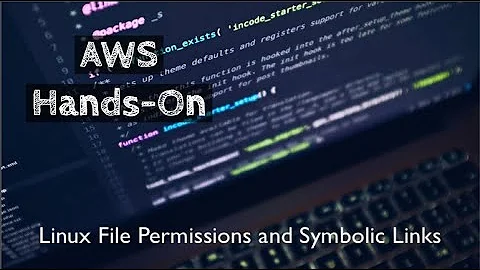How do file permissions apply to symlinks?
Solution 1
It depends on how you call chmod and the platform you are running on.
For example, on a Linux system, man chmod says this:
chmodnever changes the permissions of symbolic links; thechmodsystem call cannot change their permissions. This is not a problem since the permissions of symbolic links are never used. However, for each symbolic link listed on the command line,chmodchanges the permissions of the pointed-to file. In contrast,chmodignores symbolic links encountered during recursive directory traversals.
However, on a Mac, chmod can be used to modify the permissions of a symbolic link using options such as this (from man chmod):
-h If the file is a symbolic link, change the mode of the link itself rather than the file that the link points to.
For the sake of example, lets assume you are on a Linux machine for the rest of this answer.
If in the first case you run chmod -R 777 directory to recursively change the permissions, the link target will not be affected, but if you do chmod 777 directory/*, it will.
If you change the permissions on the link target directly, those permissions will carry through (since as man page and baraboom say, the actual link permissions aren't used for anything).
Test log for illustration:
$ mkdir dir && touch dir/file{1,2} /tmp/file3 && ln -s {/tmp,dir}/file3
$ ls -l dir/* /tmp/file3
-rw-r--r-- 1 user group 0 2011-06-27 22:02 /tmp/file3
-rw-r--r-- 1 user group 0 2011-06-27 22:02 dir/file1
-rw-r--r-- 1 user group 0 2011-06-27 22:02 dir/file2
lrwxrwxrwx 1 user group 10 2011-06-27 22:02 dir/file3 -> /tmp/file3
$ chmod -R 777 dir && ls -l dir/* /tmp/file3
-rw-r--r-- 1 user group 0 2011-06-27 22:02 /tmp/file3
-rwxrwxrwx 1 user group 0 2011-06-27 22:02 dir/file1
-rwxrwxrwx 1 user group 0 2011-06-27 22:02 dir/file2
lrwxrwxrwx 1 user group 10 2011-06-27 22:02 dir/file3 -> /tmp/file3
$ chmod 700 dir/* && ls -l dir/* /tmp/file3
-rwx------ 1 user group 0 2011-06-27 22:02 /tmp/file3
-rwx------ 1 user group 0 2011-06-27 22:02 dir/file1
-rwx------ 1 user group 0 2011-06-27 22:02 dir/file2
lrwxrwxrwx 1 user group 10 2011-06-27 22:02 dir/file3 -> /tmp/file3
Solution 2
baraboom's and peth's answers are both correct: Permission bits on the symbolic links themselves are irrelevant (except on macOS; see below), and changing permission on a symbolic link – by the chmod command-line tool or by the chmod() system call – will simply act as if it was performed against the target of the symbolic link.
To quote the SUSv4/POSIX.1-2008 description of symlink() system call:
The values of the file mode bits for the created symbolic link are unspecified. All interfaces specified by POSIX.1-2008 shall behave as if the contents of symbolic links can always be read, except that the value of the file mode bits returned in the st_mode field of the stat structure is unspecified.
Here, “unspecified” leaves room of interpretation for each implementation. Specifics:
- On Linux (tested using ext4fs),
stat()returnsst_mode=0777, no matter what the umask was when the symlink was created;ls -ltherefore always displayslrwxrwxrwxfor symbolic links. - On macOS (HFS) and FreeBSD (both UFS and ZFS), a symbolic link does have its own permission: The
chmod -hcommand noted above can change this link permission (which internally uses a non-POSIXlchown()system call to achieve this), and thestat()system call returns this value forst_mode.
Symbolic links on Linux and FreeBSD can always be followed, as specified by POSIX. In particular, on FreeBSD, this means that the file mode of a symbolic link has no effect at all on access control.
On the other hand, macOS slightly breaks POSIX. Although a symbolic link can be followed regardless its read permission, readlink() fails with EACCES (Permission denied) if the user does not have read permission:
$ sudo ln -shf target symlink
$ sudo chmod -h 444 symlink
$ ls -l symlink
lr--r--r-- 1 root staff 1 Mar 14 13:05 symlink -> target
$ sudo chmod -h 000 symlink
$ ls -l symlink
ls: symlink: Permission denied
l--------- 1 root staff 1 Mar 14 13:05 symlink
$ echo kthxbye > target
$ cat symlink
kthxbye
(Note that the -> target portion is missing in the output from the second ls -l command, and that cat symlink still succeeded and printed the contents of the target file even though the user did not have read permission on symlink.)
NetBSD apparently offers a special mount option named symperm which, if set, causes symbolic link read/execute permissions to control readlink() and link traversal.
Related videos on Youtube
n0pe
Updated on September 18, 2022Comments
-
n0pe over 1 year
Let's say you have this structure:
+ directory -- file1 -- file2 -- file3 -> /tmp/file3file3is a link to anotherfile3somewhere else on the system.Now let's say I
chmod 777the directory and all contents inside it. Does myfile3in/tmpreceive those permissions? Also, let's say we have the same situation but reversed./tmp/file3 -> /directory/file3If I apply the permissions on the file being linked to, how does that effect the link?
-
 Jailton Silva almost 13 yearsPermissions only affect the file, not the symlink.
Jailton Silva almost 13 yearsPermissions only affect the file, not the symlink. -
 Admin almost 2 yearsN.B. above comment does not quite apply to macOS, see answer from @astralblue below for the surprising behaviour there
Admin almost 2 yearsN.B. above comment does not quite apply to macOS, see answer from @astralblue below for the surprising behaviour there
-
-
 jww over 8 yearsHow does this answer the question?
jww over 8 yearsHow does this answer the question? -
 Edward Falk almost 8 yearsThat was a surprise to me too. Next question: who do the permissions on a symlink mean?
Edward Falk almost 8 yearsThat was a surprise to me too. Next question: who do the permissions on a symlink mean? -
Walf about 7 years@EdwardFalk symlink permissions are not non-restrictive since everything needs to be able to traverse it to get the permissions from the linked file.
-
 Admin almost 2 yearsDouble +1 for exposing this very surprising symlink permission behaviour on macOS -- had to confirm this for myself just now: on a symlink with restrictive permissions, the user cannot resolve the symlink, but can still use it to read and write to the target file!
Admin almost 2 yearsDouble +1 for exposing this very surprising symlink permission behaviour on macOS -- had to confirm this for myself just now: on a symlink with restrictive permissions, the user cannot resolve the symlink, but can still use it to read and write to the target file!




